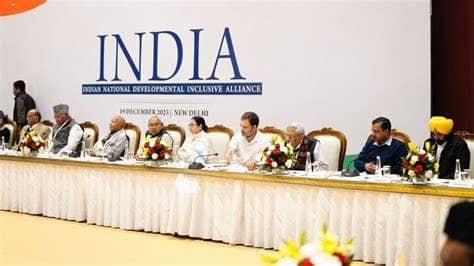There’s a lot of debate, rumors, and confusion about so-called seat sharing among the INDI Alliance. Is there any complication? Are there complex issues? Let’s examine.
Hindi Heartland
The states include UP, Bihar, Jharkhand, Chhattisgarh, MP, Rajasthan, Uttarakhand, Himachal Pradesh, and Delhi. Except UP, Bihar, Jharkhand, and Delhi, all other states have direct contests between the BJP and Congress. That means there shouldn’t be any issue with seat sharing. Rather, Congress could give a couple of seats to the BSP in Rajasthan and one seat to the SP in MP for a strong fight against the BJP’s dominance. In Delhi, both the AAP and Congress can distribute their seats in a 4:3 ratio, as both are required to do so, especially when the BJP scores more than 50% of the vote in the parliamentary election.
In Bihar, JDU is an important factor, and for the interest of the alliance, it should be given its due share, such as 16 or 17 seats. Congress has limited influence, and so do other left parties. When RJD supremo Lalu Yadav takes charge, I don’t think there will be any issue. I think Congress and the left combined will get 5–6 seats there.
In UP, Congress is totally invisible. It wins a couple of seats just because SP doesn’t give candidates against them. The important alliance in UP is between the SP and BSP. In 2019, they got 15 seats combined, whereas Congress got just one seat. Thus, SP should take charge and decide how the seats will be shared after discussing with BSP. In Jharkhand, it’s JMM in charge, and let it finalize the seat sharing as per 2019 formula.
Northern and Western non-Hindi-speaking states
These are Maharashtra, Gujarat, Punjab, Jammu, and Kashmir. In Gujarat, it’s Congress versus BJP. Congress can accommodate smaller parties like the AAP if it wishes. In J and K, there should also be no issue as the seats can be shared equally between the three parties: Congress, NC, and PDP.
In Maharashtra, it appears to be problematic. But it’s a fact that both the NCP and Shiv Sena parties split into two. Then there’s the seasoned Sarad Pawar to lead the alliance. Thus, there won’t be any issue with seat sharing as all are likely to obey Sarad Pawar’s decision.
In Punjab, there would really be an issue as there’s only two-party Congress and AAP contesting each other. The BJP has no significant presence, and SAD lost too much ground. If there will be seats shared between the AAP and Congress, then, as an alternative option, the BJP or SAD may rise. In case there’s no alliance between the BJP and SAD, I think there need not be any seat sharing between the AAP and Congress.
Southern states
In Karnataka, it’s only the Congress of the INDI Alliance that has a presence. As both JDS and BJP are in alliance, Congress can fight in all seats. However, it can also share a couple seats with the left parties for a better contest. In Tamil Nadu, there shouldn’t be an issue as the formula for seat sharing won’t be different from that of 2019.
There will be an issue in Kerala. But as the BJP is not present in that state, like Punjab, there need not be any seat sharing between the UDF and LDF. In Andhra Pradesh, neither the BJP nor Congress are available. Thus, I don’t think any seat sharing among the INDI alliance is required. In fact, no party of the INDI Alliance has any presence in that state. In Telangana, it’s Congress versus BRS and BJP, although emerging but not powerful. So, it’s Congress’s call on seat sharing and shouldn’t be an issue.
Eastern states
In Assam, it’s basically between the BJP and Congress. There’s a third-party AIUDF. It’s not in the INDI Alliance, and thus it’s up to Congress to decide how there will be seat sharing. In West Bengal, it’s totally under TMC’s control. So, Congress must accept whatever TMC offers because Congress has no influence in Bengal. Even an alliance with the left parties can’t do much. That’s why Congress should accept TMC’s offer. In any case, TMC wants to increase its tally from its 2019 numbers.
In Odisha, it’s a three-party contest among the BJD, BJP, and Congress. However, Congress can offer some seats to the left parties to boost its performance.
Northeast
Here, Congress should take the lead and form alliances with some regional parties. At the same time, it should accommodate parties like the TMC and Left in Tripura. JDU in Manipur, and so on.
Conclusion
The Congress party should realize that the 2024 general election is Congress’s election, either to win or lose. Thus, it must accommodate the regional party’s supremacy and should also do better where it’s strong. If Congress thinks it can dictate terms, then it’s committing a serious mistake. It must be humble with regional super parties, and there shouldn’t be any bossy business. It ought to take a cue from the BJP of the 1990s, which enjoyed good relations with its regional allies but occasionally surrendered to their demands as well. This seat sharing could have been easily completed in December 2023 itself. If you go on dragging this issue along, then it will be counterproductive.


